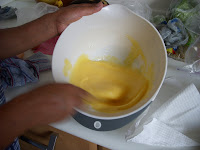
Remember when you were a kid and you would come home from school starving? I always went straight for something to tide me over until dinner. Now as adults, we somehow ignore these hunger instincts because we feel guilty about eating in between meals. As a result, we are so famished at meal times that we pick our meals with our eyes rather than our stomachs…not to mention we eat so fast that we are definitely eating way more than we should.
Stop this vicious cycle by SNACKING. Research has shown that the ideal meal plan is 3 moderately sized meals with 2-3 small snacks per day, just like when we were kids.
Why have you done a good thing?
1) Assists with weight loss – Counterintuitive as it may be, eating more can help you lose weight or stay thinner. By curbing your hunger before meals, you avoid binge eating or overindulging at meal times. Snacking also provides us with a steady structured meal plan, which helps us make healthier choices throughout the day.
2) Blood sugar control - Well-planned healthy snacks keep your blood sugar and metabolism steady throughout the day. When we don’t eat for hours, our metabolisms, as well as our blood sugars plummet. Once we eat, we send our blood sugars way up, like a rollercoaster. This can cause excess fat storage, especially if we are overindulging in carbohydrates.
3) Improves vitamin and mineral intake – Studies have shown that eating in between meals increases nutrient intake, improving calcium, vitamin C, vitamin A, and mono and polyunsaturated fat intake.
4) Sustain energy – Everyone needs energy to make it through the day, your workout, or athletic event. Snacking helps fuel our bodies for our next activities or recover from exercise.
OK, so what can I snack on?
When choosing snacks, make sure you are always making a “mini-meal” with a protein, carbohydrate and a fat for optimal nutrition. The fresher the snack is the better, but if purchasing prepackaged snacks, keep calories for each snack to less than 250 calories per serving. Aim to eat every 3-5 hours, depending on your meal size and activity levels. Listen to your body and eat when you are hungry. If your hungry after only 2 hours after a meal, always check to make sure that you are not just thirsty by drinking some water or seltzer first. Store snacks at the office, your car, and in your day bag for easy, convenient snacking!

Go-to well-balanced snack ideas:
1) Chopped carrots/peppers with hummus
2) hard-boiled egg with fresh veggies
3) Low-fat cottage cheese with berries
4) Edamame with a pinch of salt
5) ¼ cup of mixed nuts (including almonds, walnuts, peanuts) with an apple
6) ½ sandwich with natural peanut butter (no partially hydrogenated oils) and banana
7) Greek or unsweetened low-fat yogurt with a high fiber cereal, like Kashi Go Lean Crunch (Choose cereals that are 3g fiber or higher per serving)
8) Unsweetened cooked oatmeal with nuts
9) Low-fat string cheese melted over whole-wheat crackers like Wheat thins
For those of us who do snack already and are getting bored with our choices, here are some great new snack recipe ideas:
Cheesy Popcorn – 2 servings
4 cups air popped popcorn
1/2 cup freshly grated Parmesan cheese
Cayenne pepper – to taste
Toss all ingredients together to taste!
Baked Chickpeas – 4 servings

1, 15-ounce can of low-sodium chickpeas
1 tbsp extra virgin olive oil
2 teaspoons ground cumin
1 teaspoon dried oregano
¼ teaspoon all spice
¼ teaspoon salt
Preheat oven to 450 degrees F. Rinse off chickpeas and pat dry. Toss chickpeas in a bowl with other ingredients. Spread evenly on a baking sheet and bake for 25-30 minutes or until golden brown.
Not-Your-Average Hummus Dip – 6 servings
8 ounces frozen shelled edamame
¼ cup of water
2 tbsp low-sodium soy sauce
1 tbsp minced ginger
1 tbsp rice vinegar
1 tbsp tahini
1 clove minced garlic
1/8 teaspoon salt
Optional hot sauce to taste
Cook edamame per packaging. Blend all ingredients together in food processor until smooth. Serve with whole wheat crackers or veggies!

Almond Honey Power Bar – 8 servings
Adapted from EatingWell.com
1 cup old-fashioned rolled oats
1/4 cup slivered almonds
1/4 cup sunflower seeds
1 tablespoon ground flaxseeds
1 cup unsweetened whole-grain puffed cereal, such as Kashi 7 grain puffed cereal
1/3 cup currants
1/3 cup chopped dried apricots
1/3 cup chopped golden raisins
1/4 cup creamy almond butter
1/4 cup sugar
1/4 cup honey
1/2 teaspoon vanilla extract
1/8 teaspoon salt
1)Preheat oven to 350°F. Coat an 8-inch-square pan with cooking spray.
2) Spread oats, almonds, sunflower seeds, and flaxseeds on a large, rimmed baking sheet. Bake until the oats are lightly toasted and the nuts are fragrant, shaking the pan halfway through, about 10 minutes. Transfer to a large bowl. Add cereal, currants, apricots and raisins; toss to combine.
3) Combine almond butter, sugar, honey, vanilla, and salt in a small saucepan. Heat over medium-low, stirring frequently, until the mixture bubbles lightly, 2 to 5 minutes.
4) Immediately pour the almond butter mixture over the dry ingredients and mix with a spoon or spatula until no dry spots remain. Transfer to the prepared pan. Lightly coat your hands with cooking spray and press the mixture down firmly to make an even layer (wait until the mixture cools slightly if necessary). Refrigerate until firm, about 30 minutes; cut into 8 bars.
Happy Snacking!!!!
























